polyNormal
Below is a demonstration of the features of the polyNormal function
Contents
- Syntax
- Description
- Examples
- Example 1: Getting point-wise normal vectors for a 2D polygon
- Example 2: Getting point-wise normal vectors for a 3D polygon
- Example 3: Getting point-wise normal vectors for a non-closed polygon
- Example 4: Getting segment-wise normal vectors for a non-closed polygon
- Example 5: Getting point-wise normal vectors for a closed polygon
- Example 6: Getting segment-wise normal vectors for a closed polygon
clear; close all; clc;
Syntax
[varargout]=polyNormal(V_poly);
Description
UNDOCUMENTED
Examples
Plot settings
markerSize=50; lineWidth=2; fontSize=25;
Example 1: Getting point-wise normal vectors for a 2D polygon
x=linspace(0,2*pi,15)'; y=sin(x); V=[x y];
Using all defaults:
N=polyNormal(V)
N =
-0.6951 0.7190
-0.6568 0.7541
-0.5162 0.8564
-0.2103 0.9776
0.2103 0.9776
0.5162 0.8564
0.6568 0.7541
0.6951 0.7190
0.6568 0.7541
0.5162 0.8564
0.2103 0.9776
-0.2103 0.9776
-0.5162 0.8564
-0.6568 0.7541
-0.6951 0.7190
Example 2: Getting point-wise normal vectors for a 3D polygon
t=linspace(0,2*pi,15)'; x=cos(t); y=sin(t); z=2*(t./(2*pi)); V=[x y z];
Using all defaults:
N=polyNormal(V)
N =
-0.9749 -0.2225 0
-0.9010 -0.4339 0
-0.6235 -0.7818 0
-0.2225 -0.9749 0
0.2225 -0.9749 0
0.6235 -0.7818 0
0.9010 -0.4339 0
1.0000 -0.0000 0
0.9010 0.4339 0
0.6235 0.7818 0
0.2225 0.9749 0
-0.2225 0.9749 0
-0.6235 0.7818 0
-0.9010 0.4339 0
-0.9749 0.2225 0
Example 3: Getting point-wise normal vectors for a non-closed polygon
Specifying options
optionStruct.closeLoopOpt=false; %Wether the input should be considered a closed curve optionStruct.type='vertex'; % 'vertex'/'node' or 'segment'/'edge' optionStruct.zDir=[0 1 1]; %z-direction [N,VN]=polyNormal(V,optionStruct);
cFigure; hold on; hp1=plotV(V,'k.-','MarkerSize',markerSize,'LineWidth',lineWidth); hp2=quiverVec(VN,N,0.5,'r'); legend([hp1 hp2],{'Polygon','vertex normal vectors'}); axisGeom(gca,fontSize); drawnow;
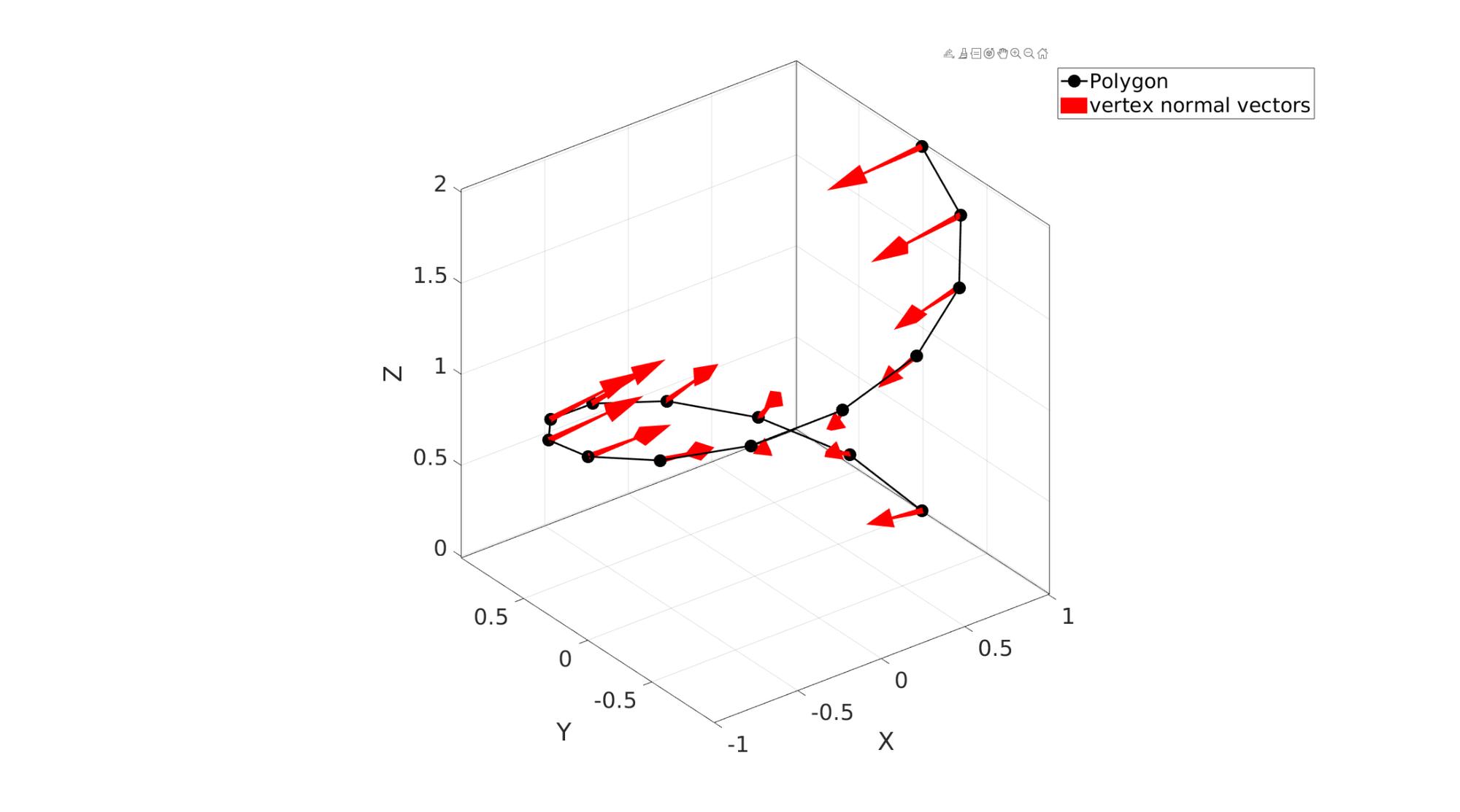
Example 4: Getting segment-wise normal vectors for a non-closed polygon
optionStruct.closeLoopOpt=false; %Wether the input should be considered a closed curve optionStruct.type='segment'; % 'vertex'/'node' or 'segment'/'edge' optionStruct.zDir=[0 0 1]; %z-direction [N,VN]=polyNormal(V,optionStruct);
cFigure; hold on; hp1=plotV(V,'k.-','MarkerSize',markerSize,'LineWidth',lineWidth); hp2=quiverVec(VN,N,0.5,'b'); legend([hp1 hp2],{'Polygon','segment normal vectors'}); axis equal; grid on; box on; set(gca,'FontSize',fontSize); drawnow;
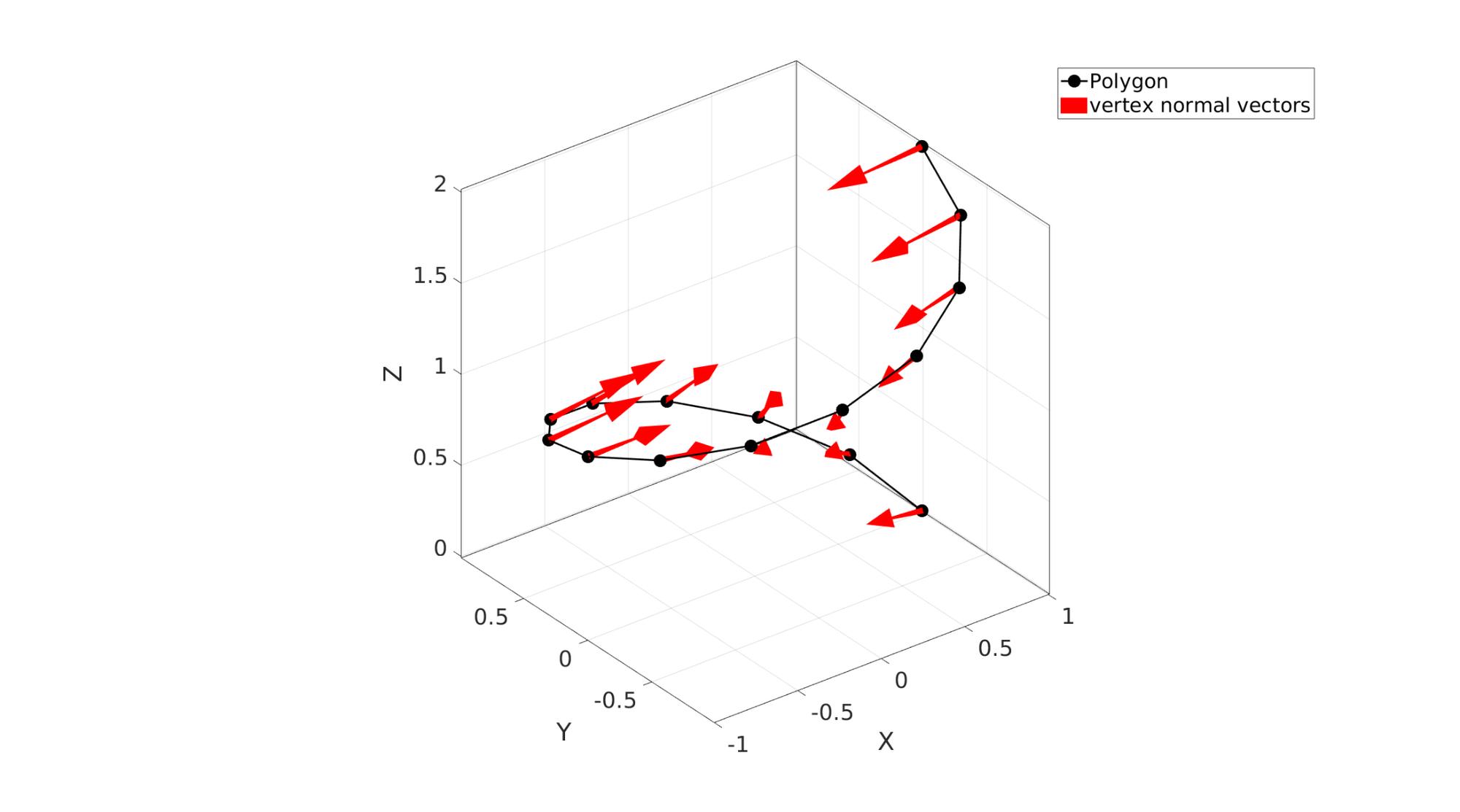
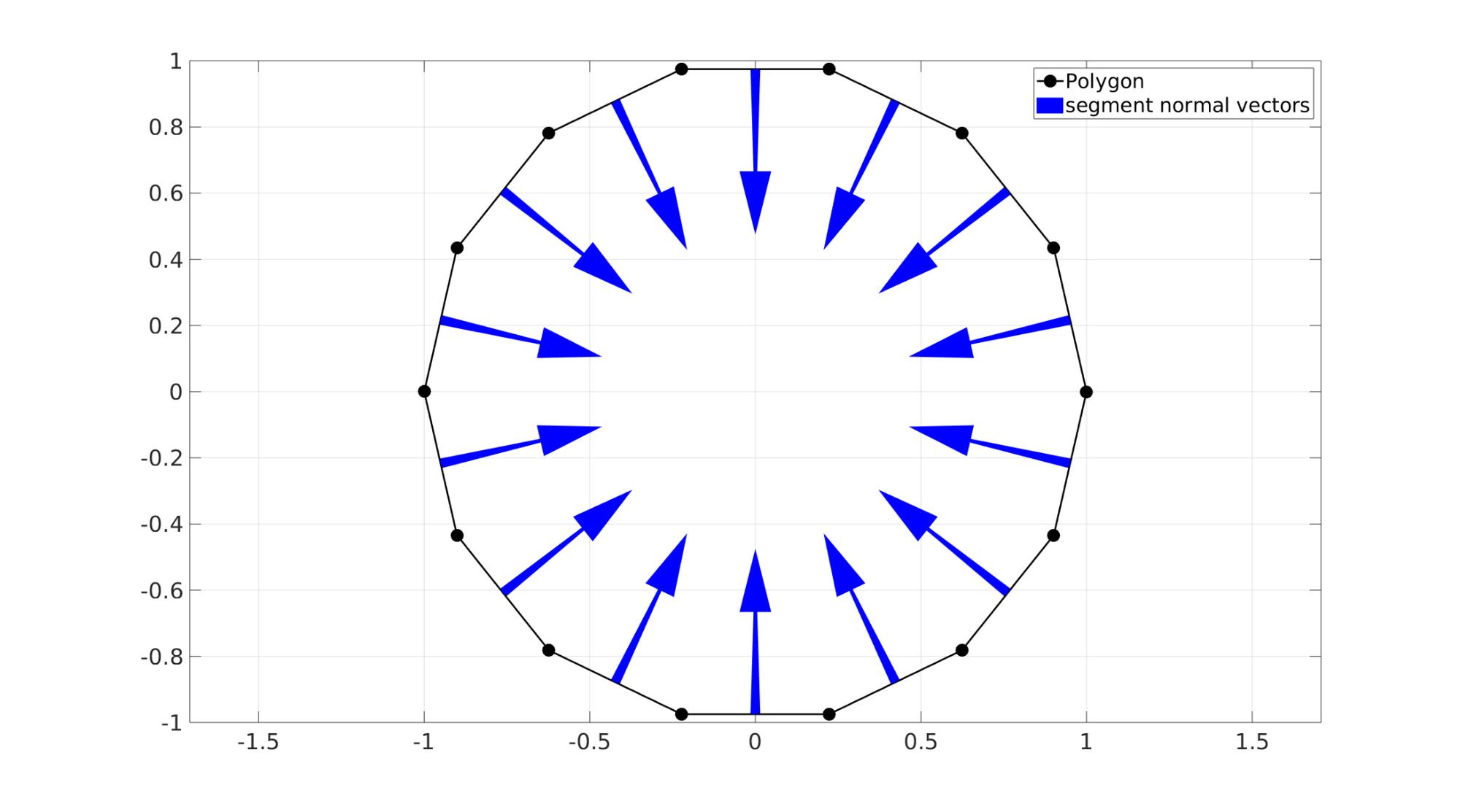
Example 5: Getting point-wise normal vectors for a closed polygon
t=linspace(0,2*pi,25)'; t=t(1:end-1); r=3; x=r*cos(t); y=r*sin(t); V=[x y]; optionStruct.closeLoopOpt=true; %Wether the input should be considered a closed curve optionStruct.type='vertex'; % 'vertex'/'node' or 'segment'/'edge' optionStruct.zDir=[0 0 1]; %z-direction N=polyNormal(V,optionStruct);
cFigure; hold on; hp1=plotV(V,'k.-','MarkerSize',markerSize,'LineWidth',lineWidth); hp2=quiverVec(V,N,1,'r'); legend([hp1 hp2],{'Polygon','segment normal vectors'}); axis equal; grid on; box on; set(gca,'FontSize',fontSize); drawnow;
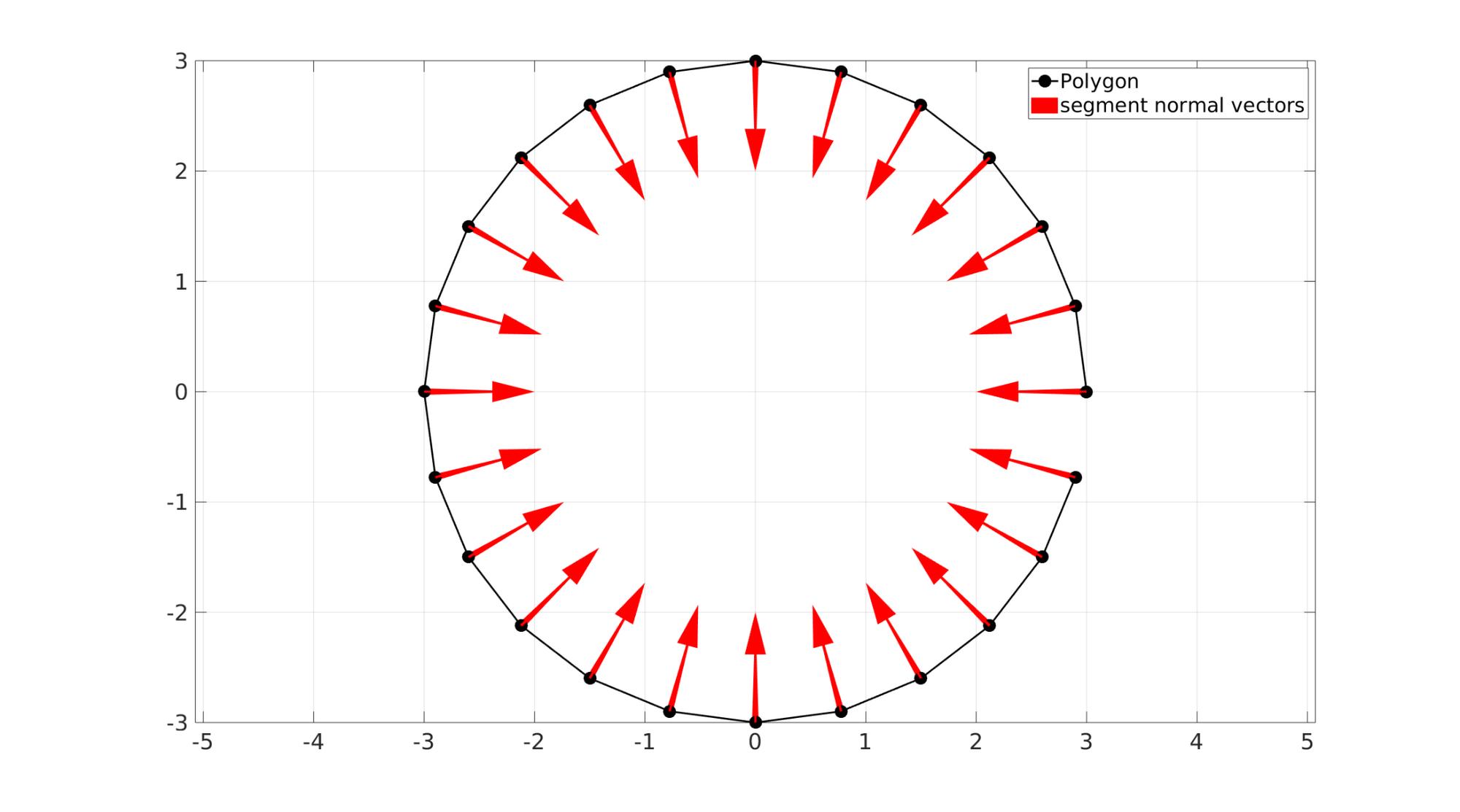
Example 6: Getting segment-wise normal vectors for a closed polygon
optionStruct.closeLoopOpt=true; %Wether the input should be considered a closed curve optionStruct.type='segment'; % 'vertex'/'node' or 'segment'/'edge' optionStruct.zDir=[0 0 1]; %z-direction [N,VN]=polyNormal(V,optionStruct);
cFigure; hold on; hp1=plotV(V,'k.-','MarkerSize',markerSize,'LineWidth',lineWidth); hp2=quiverVec(VN,N,1,'b'); legend([hp1 hp2],{'Polygon','segment normal vectors'}); axis equal; grid on; box on; set(gca,'FontSize',fontSize); drawnow;
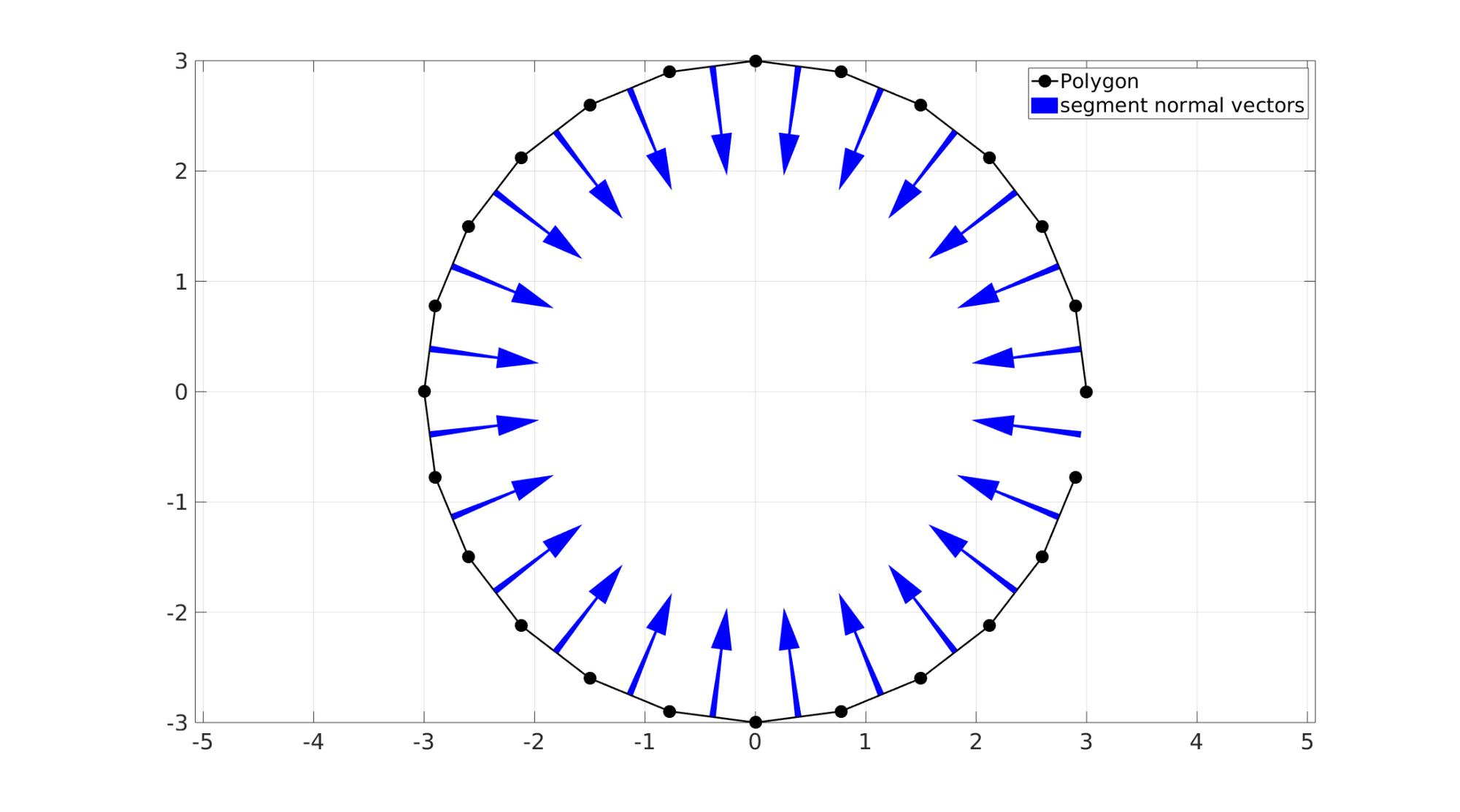

GIBBON www.gibboncode.org
Kevin Mattheus Moerman, [email protected]
GIBBON footer text
License: https://github.com/gibbonCode/GIBBON/blob/master/LICENSE
GIBBON: The Geometry and Image-based Bioengineering add-On. A toolbox for image segmentation, image-based modeling, meshing, and finite element analysis.
Copyright (C) 2006-2023 Kevin Mattheus Moerman and the GIBBON contributors
This program is free software: you can redistribute it and/or modify it under the terms of the GNU General Public License as published by the Free Software Foundation, either version 3 of the License, or (at your option) any later version.
This program is distributed in the hope that it will be useful, but WITHOUT ANY WARRANTY; without even the implied warranty of MERCHANTABILITY or FITNESS FOR A PARTICULAR PURPOSE. See the GNU General Public License for more details.
You should have received a copy of the GNU General Public License along with this program. If not, see http://www.gnu.org/licenses/.